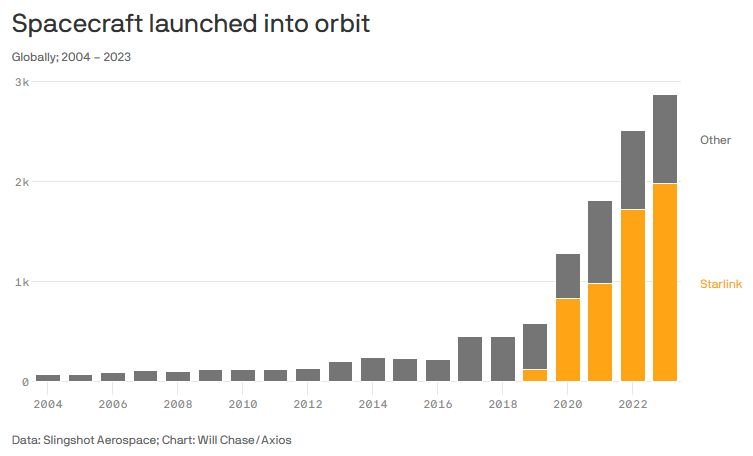
By Alison Snyder,
Published by Axios, 5 May 2024
Earth gained a record number of satellites — nearly 3,000 — last year, adding to the congestion around the planet, according to new data.
Why it matters: Crowded orbits and collisions between satellites raise the risk of creating dangerous space debris and making parts of the planet’s orbit unusable.
- “The industry has been saying space is becoming more congested for years, but now reality is setting in and the pressure is on to address the increasing risk in orbit,” Melissa Quinn, general manager at Slingshot Aerospace said in a press release. Slingshot published its first State of Satellite Deployments & Orbital Operations report on Tuesday.
By the numbers: 2,877 spacecraft were launched in 2023, a nearly 15% increase from the previous year.
- That brought the total number of satellites in Earth’s orbit to 12,597 at the end of 2023.
- Fueled by SpaceX and Starlink internet constellations, more than 91% of satellites around the planet are in low-Earth orbit (LEO) and nearly 80% of all satellites are dedicated to communications.
- 89% of satellites in operation are commercial, a reflection of the growing space economy.
But more than 3,300 satellites in orbit around Earth are inactive, “taking up valuable space,” Quinn said.
- LEO — where there are thousands of inactive satellites, including 187 retired last year — is congested.
- So is geosynchronous orbit (GEO), which is more than 22,000 miles above Earth. There are far fewer satellites in this orbit but they are critical for communications, weather and missile defense and other military purposes.
- The average distance between them dropped 33% between 2010 and 2023 to about 186 miles.
“This closer proximity for operations means that the spacecraft that are responsible for critical infrastructure here on Earth are also feeling the squeeze of a more populated GEO regime,” the report says.
- At the end of 2023, there were 508 satellites in a graveyard orbit beyond geosynchronous orbit, 25 of those satellites were moved there last year.
Between the lines: Space insurers took in about $557 million in premiums last year — and paid $995 million for losses.
The bottom line: The satellite industry’s growth coupled with concerns about space debris and challenges for space insurance “necessitate ongoing vigilance and adaptation to ensure the sustainability of space operations,” the report authors write.
Go deeper:
See: Original Article





